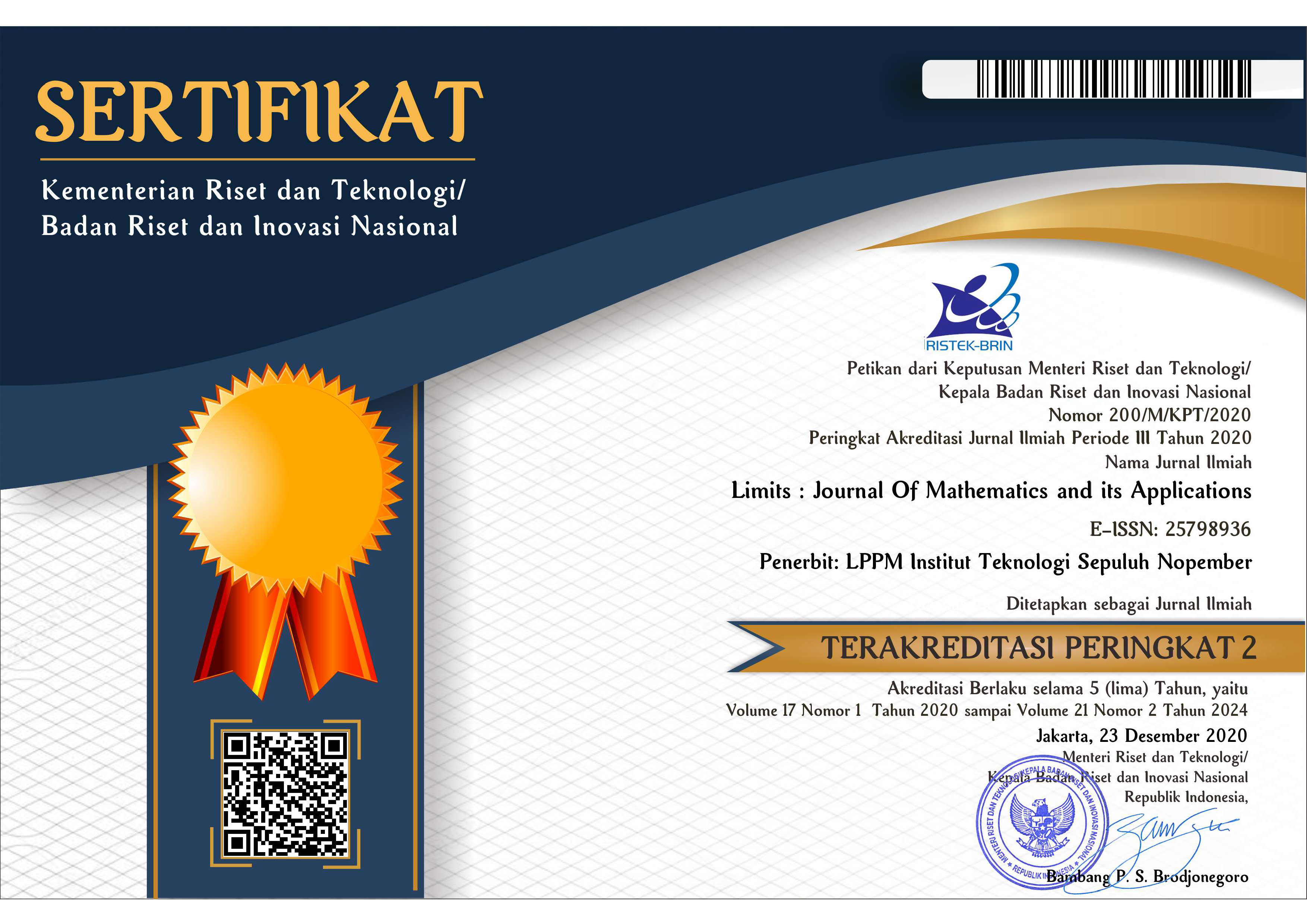Model Matematika COVID-19 dengan Vaksinasi Dua Tahap, Karantina, dan Pengobatan Mandiri
Abstract
Penelitian ini mengembangkan model SEIR untuk memodelkan penyebaran COVID-19 dengan menambahkan vaksinasi dua tahap, isolasi mandiri, karantina di rumah sakit, dan pengobatan mandiri. Pembentukan model diawali dengan membuat asumsi dan diagram transfer penyebaran COVID-19 dengan populasi dibagi menjadi sembilan subpopulasi yaitu subpopulasi rentan, subpopulasi vaksinasi dosis 1, subpopulasi vaksinasi dosis 2, subpopulasi laten, subpopulasi terinfeksi, subpopulasi isolasi mandiri, subpopulasi karantina di rumah sakit, subpopulasi pengobatan mandiri, dan subpopulasi removed, kemudian dibentuk sistem persamaan diferensial nonlinear. Dari analisis model diperoleh titik ekuilibrium bebas penyakit, titik ekuilibrium endemik penyakit, dan bilangan reproduksi dasar (R0). Titik ekuilibrium bebas penyakit stabil asimtotik lokal ketika R0<1. Eksistensi titik ekuilbirum endemik terdapat satu atau tiga akar positif jika R0>1 dan terdapat nol atau dua akar positif jika R0<1. Bifurkasi mundur terjadi pada kondisi R0<1 sehingga diperoleh persamaan bifurkasi mundur R0c<R0<1. Simulasi numerik untuk model yang dibuat sesuai dengan analisis yang telah dilakukan. Analisis sensitivitas diperoleh parameter yang berpengaruh signifikan pada penyebaran COVID-19 adalah tingkat kontak dengan individu terinfeksi dan tingkat perpindahan vaksinasi dosis satu.
Keywords
Full Text:
PDFReferences
H. A. Diah Handayani, Dwi Rendra Hadi, Fathiyah Isbaniah, Erlina Burhan, “Penyakit Virus Corona 2019,” JURNAL RESPIROLOGI INDONESIA, vol. 40, no. 3, pp. 119–129, 2020.
M. Jayaweera, H. Perera, B. Gunawardana, and J. Manatunge, “Transmission of COVID-19 virus by droplets and aerosols: A critical review on the unresolved dichotomy,” Environ Res, vol. 188, no. June, 2020, doi: 10.1016/j.envres.2020.109819.
Satgascovid-19, “Startegi Pemerintah untuk Mengatasi Covid-19.” https://covid-19.go.id/p/berita/empat-strategi-pemerintah-atasi-covif-19 (accessed Oct. 27, 2021).
Fathiyah Isbaniah and Agus Dwi Susanto, “Pneumonia Corona Virus Infection Disease-19 (COVID-19),” Journal Of The Indonesian Medical Association, vol. 70, no. 4, pp. 87–94, 2020, doi: 10.47830/jinma-vol.70.4-2020-235.
A. B. Gumel, E. A. Iboi, C. N. Ngonghala, and E. H. Elbasha, “A primer on using mathematics to understand COVID-19 dynamics : Modeling , analysis and simulations,” Infect Dis Model, vol. 6, no. August 2020, pp. 148–168, 2021, doi: 10.1016/j.idm.2020.11.005.
D. Dwomoh et al., “Mathematical modeling of COVID-19 infection dynamics in Ghana : Impact evaluation of integrated government and individual level interventions,” Infectious Disease Modelling, vol. 6, pp. 381–397, 2021, doi: 10.1016/j.idm.2021.01.008.
B. Kumar, A. Kumar, Y. Shankar, and B. Kumar, “COVID-19 created chaos across the globe : Three novel quarantine epidemic models Chaos , Solitons and Fractals COVID-19 created chaos across the globe : Three novel quarantine epidemic models,” Chaos, Solitons and Fractals: the interdisciplinary journal of Nonlinear Science, and Nonequilibrium and Complex Phenomena, vol. 138, no. May, p. 109928, 2020, doi: 10.1016/j.chaos.2020.109928.
M. Ali, M. Imran, and A. Khan, “Analysis and prediction of the COVID-19 outbreak in Pakistan,” Journal of Biological Dynamics, vol. 14, no. 1, pp. 730–747, 2020, doi: 10.1080/17513758.2020.1814883.
M. Manaqib, I. Fauziah, and E. Hartati, “Model matematika penyebaran COVID-19 dengan penggunaan masker kesehatan dan karantina,” Jambura Journal of Biomathematics (JJBM), vol. 2, no. 2, pp. 68–79, Oct. 2021, doi: 10.34312/jjbm.v2i2.10483.
R. R. Musafir, A. Suryanto, and I. Darti, “Dynamics of COVID-19 Epidemic Model with Asymptomatic Infection , Quarantine , Protection and Vaccination,” vol. 4, no. 2, pp. 106–124, 2021, doi: 10.5614/cbms.2021.4.2.3.
D. Otoo, P. Opoku, S. Charles, and A. Prince, “Deterministic epidemic model for ( SVC Sy C Asy IR ) pneumonia dynamics , with vaccination and temporal immunity *,” Infect Dis Model, vol. 5, pp. 42–60, 2020, doi: 10.1016/j.idm.2019.11.001.
S. Wiggins, Introductions to Applied Nonlinear Dynamics Systems and Chaos, 2nd ed. New York: Springer, 2000.
F. Xia, X. Yang, R. A. Cheke, and Y. Xiao, “Quantifying competitive advantages of mutant strains in a population involving importation and mass vaccination rollout,” Infectious Disease Modelling, vol. 6, pp. 988–996, 2021, doi: 10.1016/j.idm.2021.08.001.
M. Martcheva, An Introduction to Mathematical Epidemiology. New York: Springer, 2010.
Boyce, Elementary Differential Equations and Boundary Value Problems, 11th ed. New York: John Wiley & Sons, 2009.
A. Aslah and M. Daud, “A Note on Lienard-Chipart Criteria and its Application to Epidemic Models,” vol. 9, no. 1, pp. 41–45, 2021, doi: 10.13189/ms.2021.090107.
A. K. Saha and C. N. Podder, “Dynamics of novel COVID-19 in the presence of Co-morbidity,” vol. 7, pp. 138–160, 2022, doi: 10.1016/j.idm.2022.04.005.
D. Aldila, A. Islamilova, S. H. A. Khoshnaw, and B. D. Handari, “Forward Bifurcation with Hysteresis Phenomena from Atherosclerosis Mathematical Model,” vol. 4, no. 2, pp. 125–137, 2021, doi: 10.5614/cbms.2021.4.2.4.
R. Anguelov, S. M. Garba, and S. Usaini, “Backward bifurcation analysis of epidemiological model with partial immunity,” Computers and Mathematics with Applications, vol. 68, no. 9, pp. 931–940, 2014, doi: 10.1016/j.camwa.2014.06.010.
M. Rohmawati, “Backwad Bifurcation Analysis and Numerical Solution of Infectious Disease Transmission Models with Partial Immunity,” Sepuluh Nopember Institute of Technology, 2015.
M. A. Safi and A. B. Gumel, “Mathematical analysis of a disease transmission model with quarantine , isolation and an imperfect vaccine,” Computers and Mathematics with Applications, vol. 61, no. 10, pp. 3044–3070, 2011, doi: 10.1016/j.camwa.2011.03.095.
N. Nuraini, K. K. Sukandar, P. Hadisoemarto, H. Susanto, and A. I. Hasan, “Mathematical models for assessing vaccination scenarios in several provinces in Indonesia,” Infect Dis Model, vol. 6, pp. 1236–1258, 2021, doi: 10.1016/j.idm.2021.09.002.
M. Zevika, A. Triska, N. Nuraini, and G. L. Jr, “On The Study of Covid-19 Transmission Using Deterministic and Stochastic Models with Vaccination Treatment and Quarantine,” vol. 5, no. 1, pp. 1–19, 2022, doi: 10.5614/cbms.2022.5.1.1.
R. R. Musafir, A. Suryanto, and I. Darti, “Dynamics of COVID-19 Epidemic Model with Asymptomatic Infection, Quarantine, Protection and Vaccination,” Communication in Biomathematical Sciences, vol. 4, no. 2, pp. 106–124, Dec. 2021, doi: 10.5614/cbms.2021.4.2.3.
B. Yong, J. Hoseana, and L. Owen, “From pandemic to a new normal : Strategies to optimise governmental interventions in Indonesia based on an SVEIQHR-type mathematical model,” Infect Dis Model, vol. 7, no. 3, pp. 346–363, 2022, doi: 10.1016/j.idm.2022.06.004.
L. Yahya, “Sensitivity Analysis of Mathematical Model of Coronavirus Disease ( COVID-19 ) Transmission,” vol. 6, no. 2, pp. 91–99, 2020.
DOI: http://dx.doi.org/10.12962%2Flimits.v20i3.14310
Refbacks
- There are currently no refbacks.
Jumlah Kunjungan:

Limits: Journal Mathematics and its Aplications by Pusat Publikasi Ilmiah LPPM Institut Teknologi Sepuluh Nopember is licensed under a Creative Commons Attribution-ShareAlike 4.0 International License.
Based on a work at https://iptek.its.ac.id/index.php/limits.






